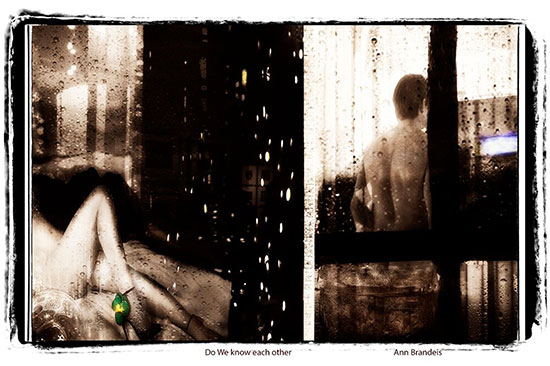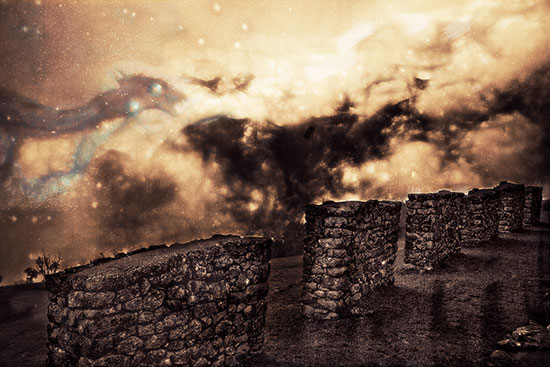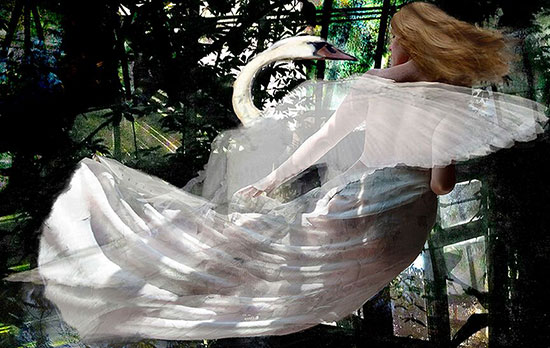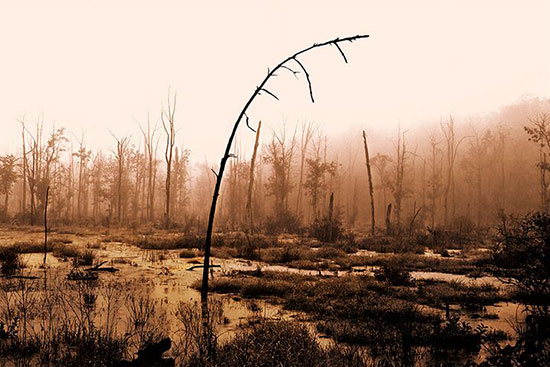On the Occasion of an exhibition at White Room Gallery in Bridgehampton, artist Ann Brandeis shares stories that led to the work on view and reveals insights into her process.
Time and Life flash away in Nano seconds, but the breadth of one's life, the feelings one remembers create a lasting, driving daily impact. This is the basic premise of Ann Brandeis's work, according to the artist.
A whisper, smell, taste, color, half awake dream are signals, which evoke a visual memory within each of us, of joy, loss, sensuality, of a time past, a fleeting moment, according to Brandeis. These continuous moments in life evoke a mood, visually arousing a viewer, causing one to remember, reflect and define that time.
Ann Brandeis combines both realism with the techniques often used by the early surrealists, the manipulation of perspective, tonality, as well as the alteration of space, thus altering the sense of reality which creates an unsettling feeling. In her images, Brandeis asks the viewer to personally engage in the work from their personal point of view or set of experiences. Photography is a visual language, a very powerful and seductive code of symbols and icons with which to communicate ideas and express sentiments, the artist says. Each image represents a visual dialogue.
Ann Brandeis presents selections from three series as part of the group exhibition "Out of Bounds" at The White Room Gallery in Bridgehampton, N.Y. The exhibition is on view July 10 to 31, 2017. In her photography, Brandeis works with the subjects of her work in a collaborative way in order to visually reflect a personal feeling or remembrance of a time gone by—a thought or memory—to make bodies of work that are immensely personal for the subject and create intimate experiences for viewers.
Through the work on view, Brandeis asks the viewer to reflect on their personal experiences. In a personal tour of the show, Brandeis gets started with Do We Know Each Other and Inca Guide.
"Do We Know Each Other"
“At a quick glance, these two images seem to have little relation to each other, yet share a similar base: loneliness, isolation, and need,” according to Brandeis. “Do We Know Each Other depicts two individuals, each partially undressed. Both living in separate spaces one feels their sense of solitude. Yet in their space, they follow the personal rituals of undressing, changing, relaxing. The image is designed to be a haunting one, where viewers can feel the solitude, loneliness and the isolation common in large cities and creates a disconnect.”
.

"do we know each other" by Ann Brandeis. Courtesy of the artist.
.
The image Inca Guide depicts the conceptual feelings and desires of the early Inca people of Peru, according to the artist. In the image, a storm has crept into the funerary area in Machu Picchu, surrounding the gravestones. Above these grave markers resides a dragon-like creature directly taken from the great Inca Map. This icon is symbolic, and represents the need for protection and guidance from their gods, states Brandeis. To the Incas, this recurring symbol is part of their heritage provided to allay their fears, sense of aloneness, she said, and it becomes their Guide, the one to protect them and lead them to a Universal truth. All components woven into Inca Guide were photographed at Machu Picchu.
.

"Inca Guide" by Ann Brandeis. Courtesy of the artist.
.
In Private Spaces, the photograph portrays the needs of individuals in a lighthearted, almost comedic fashion. The image reveals a woman unclothed and trailing a robe while searching for a temporary place to rest within her personal space, the artist explains. A flash of movement, a memory of a woman surrounded by strange lights, one can sense the universal history we all share: Privacy.
.

"Private Spaces" by Ann Brandeis. Courtesy of the artist.
.
"The Landscape of Memory"
From my point of view, memories are visceral and are not dependent upon a strict visualization of an event or a scene recreation. Rather, they often surface, sometimes unexpectedly, triggered by visual clues, sounds, smells, which serve to remind us of an experience, or component of life. Memories both personal and universal often cause us to reflect on the many paths we have taken. Signs and symbols that visually describe or capture these memories, those personal moments in time which remind us of our past, sustain us through our present, and guides our future, are what I seek.
Our memories, often conflicting, having little to do with rational thought, and resistant to logic they evoke our passions, desires, loss, and when embraced become our history. These memories mark the passage of time, reminding us that Time is both our enemy and our friend. The series “The Landscape of Memory” was created for just that type of reflection.
These concepts are explored in the image Leda's Swan. Fascinated by Greek Mythology, Brandeis has created her personal vision of the mythological tale "Leda and the Swan" in which the god Zeus, in the form of a swan, seduces or rapes Leda. The famous poem by W.B. Yeats writes:
A sudden blow: the great wings beating still
Above the staggering girl, her thighs caressed
By the dark webs, her nape caught in his bill,
He holds her helpless breast upon his breast.
Excerpt W.B. Yeats, Leda and the Swan
In creating Leda's Swan, Brandeis viewed hundreds of images of the seduction of Leda by the Swan (Zeus), with the earliest one, a woodcut in 1499, and paintings by Da Vinci, Michelangelo, Cezanne, Rubens, Correggio, as well as the most obscenely graphic painting by Boucher in 1740 which depicts the rape of Leda both harshly and pornographically. Fascinated by these tales, Brandeis created her own modern interpretation.
In Brandeis's tale, Leda is not passive. As a modern woman, Leda does not allow men or gods to decide fate; women are warriors themselves. Developing this idea, the image portrays the body and tail of the swan entwined with the wing enmeshed into the body of Leda. With Leda and her Swan directly viewing each other, there exists a consensual sexual presence, a direct viewing of each other, contemplating their passions, explains Brandeis.
.

"Leda's Swan" by Ann Brandeis. Courtesy of the artist.
.
"Drawn & Painted"
Also on view at White Room Gallery is the series "Drawn & Painted," a body of work that has special meaning for the artist.
Several years ago on a sweltering 95 degree August afternoon Brandeis recalled finding herself at a classic motorcycle show. "Just take a few pictures of the winners of the classic bikes," the organizer of the Brooklyn event asked, "and drink a lot of water, it sure is hot out here." As the heat rose, the men removed their shirts, and Brandeis stood fascinated at the tattoo choices made by this group of white, black, Hispanic, Asian, and mixed ethnicities; a true melding of people brought together through a common denominator of the motorcycle. The gathering inspired another fascination: the tattoo.
While Brandeis spoke with the men and woman at the motorcycle meet, she recognized the existence of an ongoing visual conversation and were not images in isolation. Recognizing a deep personal connection with their chosen tattoos that relates their individual history, Brandeis considers people with body art modern storytellers recounting narratives, whether myths or parables, that are personal in nature instead of representing identity with "a clan."
In one case, Ray described begin isolated from his family for years, recalled Brandeis. He chose to make his feelings stand out on his hands through the words "Nobody's Listening." His chest and back are filled with tattoes of sailing ships that express his desire to leave, said Brandeis.
.

"Nobody's Listening" by Ann Brandeis. Courtesy of the artist.
.
In the image Opposites Together, Brandeis captures a young married couple, expecting their first child. In the image, the couple stares at each other, their love and passion easily visible, she said.
.

"Opposites Together" by Ann Brandeis. Courtesy of the artist.
.
"Alluvial Lands"
The final image on view, Solitude, is part of the series "Alluvial Lands." In the series, Brandeis explores the premise of solitude and decline, the concept last one standing. The images in the series were shot in swamps, and wetlands, where the character of the environment is losing its war to the entropy of the universe. The dying of the landscape Brandeis sees as a corollary to life, and its conclusion death, which is inescapable. Yet there is a quiet beauty observing the ebbing of strength shown in swamplands. The tree stands alone, showing off its prideful nature.
Brandeis often returns to these locals, to observe any finite change. When she trudges through these landscapes, she states that she feels like the early photographers, such as Carleton Watkins or Timothy O'Sullivan, only without the wagon trains.
.

"Solitude" by Ann Brandeis. Courtesy of the artist.
.
ANN BRANDEIS
Brandeis explains her work is not that of a documentary photographer, although many of her images appear representational. It is her desire that the work allows the participant to experience a personal feeling or remembrance of a time gone by, a thought, a memory. Themes are explored in multiple portfolios: "The Landscape of Memory," "Do We Know Each Other," "Drawn and Painted," and "Alluvial Lands." As in a book, each body of work represents another chapter in her visual dialogue. Although the perceived subject changes in each portfolio, the construct, or basis of her language is continuous, engaging the viewer, and allowing personal reflections to surface. Her work is printed on uncoated all rag Exhibition Paper or handmade Japanese Kozo Paper.
The History of Photography is a major component in Brandeis's work. She has taught the History of Photography at multiple universities.
Brandeis has traveled the world, seeking images to incorporate into her visual thoughts and dialogues. She has an MFA from Pratt Institute and holds teaching positions at Rochester Institute of Technology, Fashion Institute of Technology, NYC, and Manhattan Marymount College. She has authored the book, Color Processing and Printing for Prentice Hall and has won numerous awards including multiple IPA, Luci awards, PX3 Prix de la Photographie, WPGA Awards, SPE Society for Education Juror’s Award, for Fine Art Photography.
Brandeis was chosen by the guest curator for Best Narrative image at Guild Hall 2012. Her work is included in 'The Best Photographers, 2013 and 2015 produced by Graphis Publications. Her work was spotlighted in an article published by Fine Art Magazine.
Ann Brandeis's work has been included in multiple national and international exhibitions. To see more of her art, visit her website at www.annbrandeis.com.
____________________________
BASIC FACTS: Photography by Ann Brandeis is on view July 10 to 31, 2017 in "Out of Bounds" at The White Room Gallery, 2415 Main Street, Bridgehampton, N.Y. 11932. www.thewhiteroom.gallery.
____________________________
Copyright 2017 Hamptons Art Hub LLC. All rights reserved.
